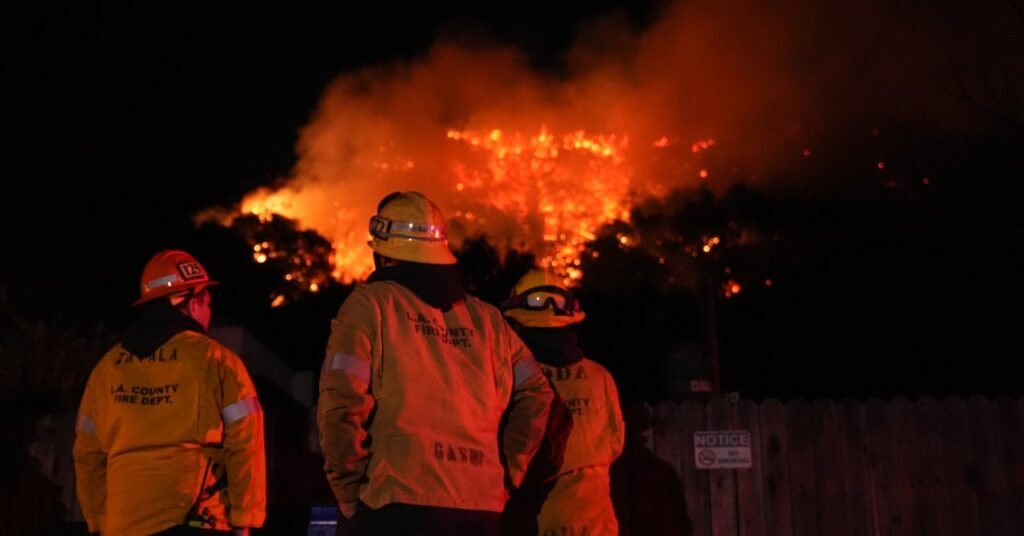Devastating wildfires continued to burn across the greater Los Angeles area on Friday, prompting an expansion of mandatory evacuations and school closures across the region. The next week promises little relief; Conditions remain favorable for both the spread of existing wildfires and the initiation of new fires as gusty winds continue in unusually dry conditions.
Officials reported five major fires throughout the Los Angeles area starting Friday morning. The Palisade fire in Pacific Palisades and Malibu has consumed more than 20,000 acres while the Eaton Fire in Altadena has grown to over 10,000 acres. It is believed that at least 10,000 buildings were destroyed and 10 people were killed across Los Angeles.
Favorable fire weather requires dry vegetation, low humidity and strong winds. The combination of these ingredients can cause fires to start easily and spread quickly. It was this dangerous mix that allowed the Palisades Fire and Eaton Fire to expand to the point where crews could no longer control them earlier in the week.
The firefighters have now succeeded start control the firessupported by reinforcements from outside the state, the water in fire hydrants filled upand the wind speed decreases. (The measures not only contributed to the fires spreading quickly Strong seasonal Santa Ana winds will blow early in the week (At times, firefighting planes were unable to fight the fires with water and fire-retardant chemicals.) The bad news is that those winds may now be picking up again — and that conditions on all other fronts are unlikely to be of interest any time soon the firefighters.
What happens next to the weather?
The Storm Prediction CenterThe National Weather Service agency tasked with issuing fire weather forecasts says the fire danger will remain elevated across Los Angeles into the weekend.
We could see two more moderate wind events in Santa Ana in the coming days – one early in the day on Sunday and another possibly on Tuesday. These gusts could encourage the spread of existing fires and the development of additional fires.
A Santa Ana wind event occurs when there is a pressure difference between the Great Basin – the vast swath of land in Nevada and Utah – and the coastal communities surrounding Los Angeles.
Meteorologists often use the air pressure difference between Las Vegas and Los Angeles to predict these winds. A greater pressure difference creates stronger winds that blow toward the coast, fueling existing wildfires. This is what they predict we could see again in the coming days.
Vegetation will also continue to be exceptionally dry across the region. It’s the middle of the rainy season in Southern California – and yet there’s no rain to be found anywhere. After experiencing the third wettest February on record last year, Los Angeles International Airport reported just 0.03 inches of rain since the start of last summer.
Although mid-January is the peak time for the rainy season in Los Angeles, there is little hope for significant rain in the next week and a half. NOAA’s Climate Prediction Center announced Thursday that we have officially entered La Niña, a pattern of colder than normal water temperatures in the Pacific Ocean around the equator. Changes in the atmosphere in response to La Niña can cause the jet stream to move northward across the Eastern Pacific, shifting storms to the west coast of Canada rather than the western United States and causing states like California to suffer from rainfall.
On time, the dominant storm track over the Pacific Ocean will remain near the Gulf of Alaska through mid-January, giving little opportunity for rain to reach Southern California.
Forecasters expect La Niña to remain weak through the end of winter, and chances are good that the pattern will fade in time for spring. Unfortunately, this timing could coincide with the start of the dry season in Southern California.
That’s not to say we may not see rain opportunities in the coming months. However, vegetation across the region will remain exceptionally dry with little or no rain until at least mid-January. The continued risk of new fires and additional fire growth will depend on periods of low humidity and gusty winds – and any further wind events in Santa Ana could prove dangerous in the coming weeks.





